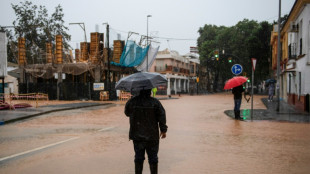
-
 Film's 'search for Palestine' takes centre stage at Cairo festival
Film's 'search for Palestine' takes centre stage at Cairo festival
-
Oil execs work COP29 as NGOs slam lobbyist presence
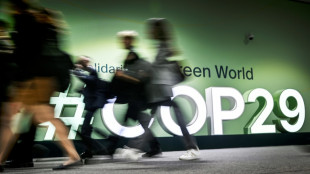
-
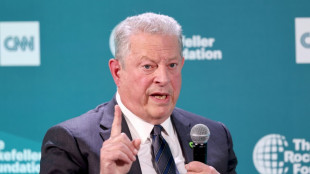 Gore says climate progress 'won't slow much' because of Trump
Gore says climate progress 'won't slow much' because of Trump
-
'Megaquake' warning hits Japan's growth

-
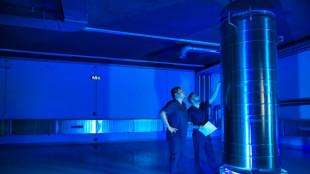 Stiff business: Berlin startup will freeze your corpse for monthly fee
Stiff business: Berlin startup will freeze your corpse for monthly fee
-
Wars, looming Trump reign set to dominate G20 summit

-
 Xi, Biden attend Asia-Pacific summit, prepare to meet
Xi, Biden attend Asia-Pacific summit, prepare to meet
-
Kyrgios to make competitive return at Brisbane next month after injuries

-
 Dominican Juan Luis Guerra triumphs at 25th annual Latin Grammys
Dominican Juan Luis Guerra triumphs at 25th annual Latin Grammys
-
Landslide win for Sri Lanka president's leftist coalition in snap polls

-
 Australian World Cup penalty hero Vine takes mental health break
Australian World Cup penalty hero Vine takes mental health break
-
As Philippines picks up from Usagi, a fresh storm bears down

-
 Tropical Storm Sara pounds Honduras with heavy rain
Tropical Storm Sara pounds Honduras with heavy rain
-
Pepi gives Pochettino win for USA in Jamaica

-
 'Hell to heaven' as China reignite World Cup hopes with late winner
'Hell to heaven' as China reignite World Cup hopes with late winner
-
Rebel attacks keep Indian-run Kashmir on the boil

-
 New Zealand challenge 'immense but fantastic' for France
New Zealand challenge 'immense but fantastic' for France
-
Under pressure England boss Borthwick in Springboks' spotlight

-
 All Blacks plan to nullify 'freakish' Dupont, says Lienert-Brown
All Blacks plan to nullify 'freakish' Dupont, says Lienert-Brown
-
TikTok makes AI driven ad tool available globally

-
 Japan growth slows as new PM readies stimulus
Japan growth slows as new PM readies stimulus
-
China retail sales pick up speed, beat forecasts in October

-
 Asian markets fluctuate at end of tough week
Asian markets fluctuate at end of tough week
-
Gay, trans people voicing -- and sometimes screaming -- Trump concerns

-
 Argentina fall in Paraguay, Brazil held in Venezuela
Argentina fall in Paraguay, Brazil held in Venezuela
-
N. Korean leader orders 'mass production' of attack drones

-
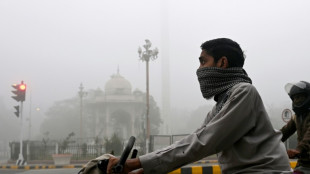 Pakistan's policies hazy as it fights smog
Pakistan's policies hazy as it fights smog
-
Nature pays price for war in Israel's north

-
 New Zealand's prolific Williamson back for England Test series
New Zealand's prolific Williamson back for England Test series
-
Mexico City youth grapple with growing housing crisis

-
 After Trump's victory, US election falsehoods shift left
After Trump's victory, US election falsehoods shift left
-
Cracks deepen in Canada's pro-immigration 'consensus'

-
 Xi inaugurates South America's first Chinese-funded port in Peru
Xi inaugurates South America's first Chinese-funded port in Peru
-
Tyson slaps Paul in final face-off before Netflix bout

-
 England wrap-up T20 series win over West Indies
England wrap-up T20 series win over West Indies
-
Stewards intervene to stop Israel, France football fans clash at Paris match

-
 Special counsel hits pause on Trump documents case
Special counsel hits pause on Trump documents case
-
Japan's Princess Mikasa, great aunt to emperor, dies aged 101
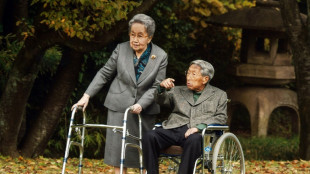
-
 Cricket at 2028 Olympics could be held outside Los Angeles
Cricket at 2028 Olympics could be held outside Los Angeles
-
Trump names vaccine skeptic RFK Jr. to head health dept

-
 Ye claims 'Jews' controlling Kardashian clan: lawsuit
Ye claims 'Jews' controlling Kardashian clan: lawsuit
-
Japan into BJK Cup quarter-finals as Slovakia stun USA

-
 Sri Lanka president's party headed for landslide: early results
Sri Lanka president's party headed for landslide: early results
-
Olympics 'above politics' say LA 2028 organisers after Trump win

-
 Panic strikes Port-au-Prince as residents flee gang violence
Panic strikes Port-au-Prince as residents flee gang violence
-
Carsley hails England's strength in depth as understudies sink Greece

-
 Undefeated Chiefs lose kicker Butker to knee injury
Undefeated Chiefs lose kicker Butker to knee injury
-
Wallabies winger Vunivalu signs for La Rochelle

-
 Musk met Iran UN ambassador on defusing tension under Trump: NYT
Musk met Iran UN ambassador on defusing tension under Trump: NYT
-
Vinicius misses penalty as Brazil held in Venezuela

| RBGPF | 100% | 61.84 | $ | |
| RELX | -0.37% | 45.95 | $ | |
| SCS | -0.75% | 13.27 | $ | |
| NGG | 0.4% | 62.37 | $ | |
| RIO | -0.31% | 60.43 | $ | |
| CMSC | -0.24% | 24.55 | $ | |
| BP | 1.65% | 29.05 | $ | |
| BTI | 0.2% | 35.49 | $ | |
| AZN | -0.38% | 65.04 | $ | |
| GSK | -2.09% | 34.39 | $ | |
| RYCEF | -4.71% | 6.79 | $ | |
| JRI | -0.23% | 13.21 | $ | |
| BCC | -1.57% | 140.35 | $ | |
| CMSD | -0.02% | 24.725 | $ | |
| VOD | -0.81% | 8.68 | $ | |
| BCE | -1.38% | 26.84 | $ |

Got to have faith: religion finds its moment at COP28
From meditation to spiritual guidance to indigenous hymns, the vibe in the "faith pavilion" at COP28 is a little different to elsewhere at the high-stakes UN climate talks in Dubai.
Orthodox priests rub shoulders with Emiratis in flowing white robes and Jewish rabbis in the quiet, air-conditioned calm of the pavilion, the first ever dedicated to religion at a COP conference.
Housed in a building of dark glass and geometric triangles, the pavilion offers a space for quiet reflection away from the frenetic diplomacy and flashy business shows that accompany the marathon climate negotiations.
It also offers something else sorely needed at COP -- unity and optimism.
"This testifies to the willingness to work together," Pope Francis said in a video message at the pavilion's inauguration on December 3 in a united call to action with senior Muslim cleric Ahmed al-Tayeb, the grand imam of Al Azhar.
"Today, the world needs alliances that are not against someone, but for the benefit of everyone."
Visitors joining daily "ritual relaxation" sessions or engaging with religious leaders in a lounge room are invited to consider the role of faith in addressing the challenge of global warming.
"For a fairer and more sustainable world, we trust and pray," one visitor wrote on a paper cut-out tree pinned alongside other messages of hope and solidarity to the pavilion wall.
- Spiritual crisis -
Organisers say more than 300 faith leaders from all major religions and traditional beliefs are expected to participate in the pavilion during the two-week-long conference being held in the glitzy Gulf city.
This is the first time in nearly 30 years of global climate talks that religion has been given its own venue, and the striking space has prime real estate in the buzzing heart of an enormous complex.
This COP is the largest ever and thousands of people walk by the pavilion every day, whether en route to meetings and expo shows, or to buy ice cream from a stall doing brisk trade out front.
The COP can be an overwhelming experience, and faith leaders hope attendees of all creeds embrace the pavilion as a respite from the haggling, heat, and anxiety over the planet's future.
Organisers say attendance at daily meditation sessions has so far been small but could uptick as negotiations toward a final climate deal intensify in the coming days.
On a recent day at the pavilion, Panamanian indigenous leader Jocabed Solano performed a spiritual song of her Guna people that extols respect and stewardship for the planet.
"It's not only the crisis of the climate, it's a crisis of the spirituality too," she told AFP after enrapturing audiences at the pavilion.
- Bridge the gap -
Behind the scenes, organisers say the pavilion is supporting progress toward an ambitious pact to limit global warming, that also ensures financial aid for the world's poorest on the frontlines of climate change.
Faith leaders are offering moral and pastoral services to diplomats working around the clock on the agreement, and for the first time have interfaith representatives attending the formal negotiation sessions.
"We want to bring that spiritual understanding to the decision-making process," Iyad Abumoghli, the director for Faith for Earth, an initiative within the UN Environment Programme, told AFP.
Panels at the pavilion have explored difficult themes including the climate-related loss of homeland, mining in Africa, and ethical investing, and speakers have included government ministers, academics and business leaders.
Faith leaders also issued an interfaith statement in support of reducing and eventually exiting fossil fuels -- a flashpoint issue at the conference overseen by an Emirati oil executive.
The pavilion seeks to foster trust -- a vital element at any COP -- between scientific and religious communities that haven't always seen eye-to-eye.
"I know it's all about science," Mohamed Bahr from the Muslim Council of Elders, told AFP. "But we're trying here to bridge the gap between science and faith."
C.Meier--BTB

